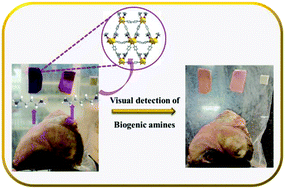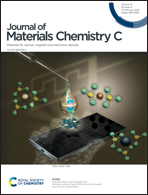MOF sensors for food safety: ultralow detection of putrescine and cadaverine in protein rich foods†
Abstract
Here we explore MOFs for the real-time detection of food spoilage indicators such as putrescine and cadaverine in protein rich foods such as fish and cheese. Biogenic amines (BAs) such as putrescine and cadaverine present in protein rich foods like cheese and fish are an important class of amine compounds required in small amounts for the normal functioning of cells. However, large amounts of these substances in foods indicate food spoilage and consumption of such foods can lead to cytotoxicity and other severe complications in the human body. It is highly desirable to design suitable materials that can detect these food spoilage indicators at low concentrations. Metal–organic frameworks (MOFs) due to their porous nature and well-defined 3D structures can serve as potential candidates for the sensing of biogenic amines. Herein, two new Co-based MOFs have been reported for the detection of putrescine and cadaverine in protein rich foods using the fluorescence technique. In addition to putrescine and cadaverine, various other biogenic amines such as spermine, spermidine, tyramine, and tryptamine have also been studied to check the wide sensing ability of these new materials. Both the MOFs show unprecedented “turn-off” fluorescence behaviour with more than 90% quenching efficiency in the presence of very low concentrations of putrescine and cadaverine. The phenomenon can be observed in both solution and solid states. Real-time sensing experiments with fish and cheese samples have been performed, which demonstrate the potential of these MOF materials in sensing biogenic amines. A plausible mechanism has also been proposed for the underlying detection mechanism.



 Please wait while we load your content...
Please wait while we load your content...